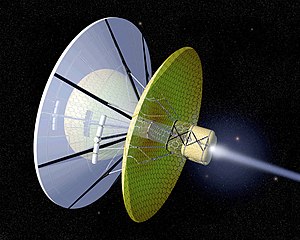Bussard Ramjet
The Bussard ramjet (also known by its English name of Bussard ramjet) is a futuristic concept of jet propulsion for space vehicles, proposed in 1960 by the physicist American Robert W. Bussard, and popularized by Poul Anderson's novel Tau Zero, by Larry Niven in his Known Space book series, by Vernor Vinge in his Zones of Thought series, and by astronomer and popularizer Carl Sagan, in his television series and book Cosmos. Bussard ram collectors have also been seen in the television series Star Trek, where they are located at the bright ends of ships' warp pods, although hydrogen is not It is used as nuclear fuel.
Concept
The concept of the Bussard ramjet proposes the collection of hydrogen present in the interstellar medium to generate with it a controlled nuclear fusion reaction and obtain an acceleration, using a gigantic collector (of the order of tens of thousands of kilometers) that it would capture the hydrogen atoms, the most abundant element in the Universe, and would take them to an engine and this would propel them from behind accelerated to almost the speed of light. Or you could use a magnetic laser grid to attract hydrogen atoms, greatly reducing their size. According to Sagan, such an engine would be the size of a satellite or a small planet.
The problem is that in open space there are very few atoms per m³ of volume, so the collector would have to be gigantic in size. To save mass, some propose using a laser to charge hydrogen atoms and then trap the nearest atoms with a very strong magnetic field. Thus, the suction device would have an acceptable size.
Most efficient method: ionization
Since there are very few hydrogen atoms per m³ of space, the network to collect enough fuel would be kilometers in size. Being so large, the gas itself would slow it down, due to friction. This is known as a "Bussard parachute".
The best solution would be to use small laser gratings, which would ionize interstellar gas. Ionized hydrogen would be drawn into the gratings. This device would have a long range, which eliminates the need to build a giant network and solves the "Bussard parachute" problem.
It could avoid friction, repelling gas in the same way that it attracts it. This method, although not officially accepted or described, has been used on Star Trek; where the ships have nacelles capable of absorbing hydrogen as vacuum cleaners.
This device could be powered by a battery or a solar sail, just as safe as fusion, as a method of gaseous ionization and fusion inducer.
Ship Features
- Atoms would come out almost at the speed of light. In ideal conditions the ship would also achieve this speed and could reach the limits of the universe known in about 55 years, for a crewman and for the ship itself. For an external observer, on Earth for example, more than 5 billion years would have elapsed, for the purpose of dilating time. This would not happen in reality, since:
- It is accepted that a ship of this kind would reach up to 10-20% of the speed of light, which would be optimal to make interplanetary trips quickly. Still, it's still slow for interstellar travel.
- It feeds a fusion reactor, which is safe for crew members due to the absence of toxic or radioactive substances. The fusion fuel and what the statorrector should absorb is the hydrogen, and the residue it produces is helium.
- Likewise, the acceleration capacity of the ingenuity would only be limited by the physical resistance of its crew members. This problem could be solved with a hypothetical "inertia anulator".
Problems and drawbacks
- A motor like that of the statorrector could generate so much heat that would be dangerous for crew members, which is why it should be well armored, which means more mass. Although we now know that this would not be a big problem, as fusion energy can be controlled by magnetic fields.
- Recent calculations made by the aerospace engineer Robert Zubrin have shown that the scant resistance opposed by the particles present in the interstellar medium, to the scale of the collector needed to collect them, would be greater than the acceleration obtained with the nuclear fusion of the absorbed material. This has generated the concept of brake or parachutes Bussard. However, using a magnetic grid to divert space gas the same way that attracts it is an efficient solution.
The Bussard ramjet in literature
The Bussard ramjet concept has been used in some famous hard science fiction novels, such as Larry Niven's Ringworld series or Poul Anderson's Tau Zero. In Star Trek, almost all ships use fusion to travel at sub-light speeds, and they use the Bussard ramjet.
The Bussard ramjet has been proposed in both speculative scientific literature and science fiction as one of the few viable alternatives for interstellar travel, because it would make it unnecessary to carry fuel all the way, in addition to being able to accelerate continually.
Contenido relacionado
Boots
Plutinus
Buffy the Vampire Slayer (TV series)
